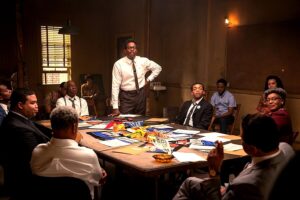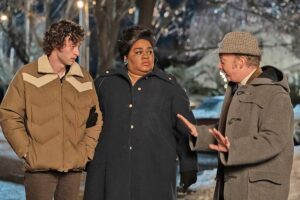Bayard Rustin is an important yet obscure figure of the civil rights movement, and his time has come. A close adviser to Martin Luther King Jr. — it was Rustin who persuaded King to adopt Gandhi’s credo of nonviolent civil disobedience — he was a key organizer of several historic demonstrations, including the 1963 March on Washington for Jobs and Freedom, which brought 250,000 people to the Lincoln Memorial to hear King give his “I Have a Dream” speech. Rustin’s obscurity is due to his deliberate avoidance of the spotlight, which was a practical necessity. Being Black, unapologetically gay, and a former Communist made him a walking scandal in the 1950s — a political untouchable. Yet he survived and achieved extraordinary success.
President Obama posthumously awarded Rustin the Presidential Medal of Freedom in 2013, and now Barack and Michelle Obama’s production company is behind a new biopic, Rustin, which had a brief run in theaters and is now streaming on Netflix. The film is directed by George C. Wolfe, who is Black and gay and a titan of New York theater. It has a high-profile cast, headed by Colman Domingo as Rustin (dazzling — and a likely award contender) and featuring an unconvincing Chris Rock as NAACP leader Roy Wilkins, an unctuous Jeffrey Wright as U.S. Rep. Adam Clayton Powell Jr., and, to pump up the minimal representation of women in the movement, CCH Pounder and Audra MacDonald in small roles. Dustin Lance Black, an Oscar winner for Milk, worked on the script.

But despite a wealth of talent working overtime with the best of intentions, the film is fairly conventional and unaffecting. There are several reasons for this. Wolfe, who did a respectable film adaptation of August Wilson’s Ma Rainey’s Black Bottom (also featuring Domingo), tends to clutter things up and hype the material, even in his stage productions. With a subject like Rustin, whose expertise was largely behind the scenes, that impulse just seems cheap. The loud and jazzy score, and the rat-a-tat action of the office scenes, force-feed an aura of entertainment. It might work in a movie such as Everything Everywhere All at Once, which spoofs its own complexity, but in Rustin, the overdramatization belittles the whole enterprise.
Some of the supporting roles are underwritten with wooden dialogue. A fictional character who was added — a married Black pastor who is attracted to Rustin but can’t make the leap to gay romance — feels a bit schematic. The relationship between Rustin and King (played by a mild-mannered Ami Ameen), two of the most formidable minds of the movement, lacks electricity.
And finally, the script, structured like a TV procedural, is far too narrow in scope. Rustin led a long and fascinating life, but the movie limits itself to his organizing effort for the 1963 march, which was a comeback of sorts for him. Cutting back further, the movie leaves out the climactic moment of the march, which is King’s speech. Whatever the reason for its absence, it diminishes the event’s impact and Rustin’s accomplishment.
Another biopic with limited scope, Sofia Coppola’s Priscilla, has been playing recently in local theaters with no streaming date announced. It tells the story of how Priscilla Beaulieu met Elvis Presley in West Germany in 1959, when she was the bored and lonely 14-year-old daughter of a U.S. Air Force officer. Presley, then 24 and an international rock ’n’ roll sensation, was carrying out his military service there.

The two fell in love, at least according to Priscilla. Through a contemporary lens, the relationship looks a lot like Presley grooming a child — something Priscilla and Elvis’s daughter, Lisa Marie Presley, publicly objected to after reading an early version of the script.
The courtship in Germany lasted a few short months, and Elvis soon returned home to his pop-star life. But after two years of phone calls between them, Priscilla’s parents were persuaded to let her move close to Graceland, Elvis’s near-mythical home in Memphis, to finish high school. Before long, she eluded their authority and became his live-in girlfriend at age 17.
Elvis continued to have well-publicized affairs with his costars in Hollywood, leading Priscilla to doubt the validity of their relationship, which was romantic and (she insists) not fully consummated. (Coppola adapted the script from Priscilla’s memoir, Elvis & Me.) The two saw no need to get married right away, but pressure of all kinds — familial, professional, societal — pushed them to wed in 1967, and Lisa Marie was born nine months later.
Elvis’s increasing drug use and constant touring put a strain on their marriage, however, and in 1973, after he “forcefully” had sex with her — a stark contrast to the childlike nature of their relationship, as Priscilla wrote in her memoir — she knew it was time to leave. And that’s where the movie ends.
The couple divorced amicably, and Elvis died four years later. Priscilla eventually became executor of his estate and managed to turn his dwindling fortune into a well-run business, with Graceland as the main attraction. These later developments add an aura of female empowerment to the tale of Priscilla’s life, but Coppola seems content to focus only on her 14 years as Elvis’s main squeeze.
As a writer and director, Coppola clearly understands the distortions of a life of wealth and superstardom — the cooped-up loneliness, the surreal situations — as she so amply demonstrated in Lost in Translation. Priscilla is lushly photographed by Philippe Le Sourd and mostly keeps a discreet, gauzy distance from its characters. Cailee Spaeney as Priscilla and Jacob Elordi as Elvis give fine performances, and as biography, Priscilla feels authentic. But it doesn’t seem to have much of a reason for being besides offering a glimpse of life inside Graceland. There’s little sense of Elvis’s talent, but it’s not his story — it’s Priscilla’s, and her emergence from Elvis’s celebrity cocoon doesn’t have much universality.
If anyone could squeeze some relevance out of the rarefied lives of rich Americans, it’s Alexander Payne. Payne likes to focus his jaundiced Midwestern eyes on deeply flawed and mostly unlikable characters, from Laura Dern’s pregnant glue-sniffer in Citizen Ruth to Paul Giamatti’s pretentious wine enthusiast in Sideways. And now, with The Holdovers, which is currently screening in local theaters, he has given Giamatti another wonderfully abrasive role — that of classics teacher Paul Hunham at the all-male boarding school Barton Academy (a fictional campus shot largely in Deerfield, Mass. with a “field trip” to Boston).

The time is December 1970, and while the rest of the country is going through the upheaval of the Vietnam War, Barton students still live in a pseudo-aristocratic bubble, wearing jackets and ties and constantly trading competitive and nasty jabs. Forget peace and love and flower power. Hunham is a single, alcoholic misanthrope nearing retirement who uses his knowledge of ancient works to berate his students. He enjoys giving them failing grades, which he deems they deserve, and he resents their spoiled, privileged lives.
He also hates playing the elitist political games that govern Barton, so it’s not surprising that his headmaster (a former student) selects him to remain on campus over the Christmas holidays to supervise the “holdovers,” students who have nowhere else to go. Among this group, Hunham mainly has it in for Angus Tully (Dominic Sessa), a loner not unlike Hunham himself, who challenges adherence to the rules every chance he gets.
During their weeks in relative isolation, when everyone else is cozying up to their families, Hunham and Angus learn each other’s secrets and forge a bond. Helping to mediate tensions between them is the school’s bitter and straight-talking head cook, Mary Lamb (Da’Vine Joy Randolph). Lamb is Black, and her son attended Barton before going to Vietnam, where he was killed. She sees the common-sense humanity that will end a standoff when Hunham can’t.
Payne is a meticulous storyteller. Working with an original script by David Hemingson, he fills up The Holdovers with a million details (a car door that doesn’t open; a snow globe in a mental institution) and knows just how long and how far each comic or dramatic bit should go in this colorful but predictable story. The result is magical, from the performances of all three leads to the depth of satisfaction one feels at the end. The world is still a mess, but somehow we feel just a little bit smarter about it.
